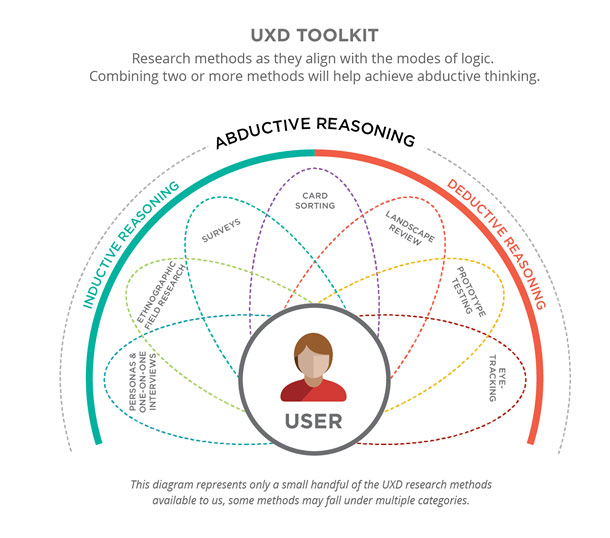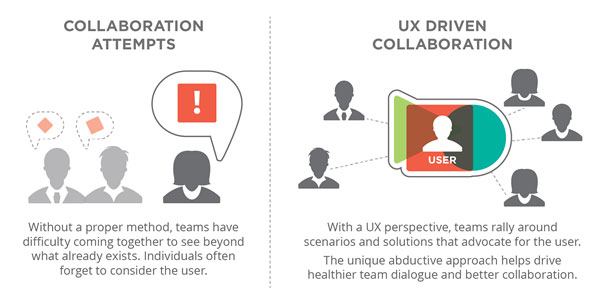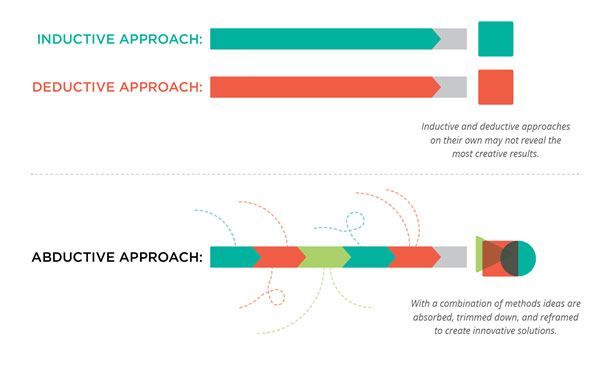When trying to solve a business problem, many corporate teams rely on one type of logic. The result: instead of collaborating, the members end up in a power struggle over whose idea will win. It’s frustrating for the team at large, and the solution chosen may be only temporary. Worse, teams may disband before the initial problem is solved. In contrast, by borrowing from traditional academic approaches to problem solving, UX designers use three types of logic to create better solutions (see Figure 1):
- Inductive logic (generalize solutions that already exist)
- Deductive logic (narrow down existing choices)
- Abductive reasoning (a combination of inductive and deductive methods that encourages expansive thinking)

Let’s break down these three concepts using design-related analogies. When creating user personas, for instance, teams will often use a collection of one-on-one interviews to validate assumptions about user archetypes. Think of this as a mode of inductive reasoning, as many voices come together to inform the team’s understanding.
On the flip side, by using the powers of deduction you can look at existing solutions and then whittle away the options that don’t fit. In A/B testing, for example, UX designers can create two viable versions of a wireframe to identify which performs better with a group of key users.

Though inductive and deductive methods are both valid, they can limit our range of choices. Abductive reasoning, on the other hand, uses a combination of UXD methods to better understand what is possible and to provide us with permission to think beyond what’s already there (see Figure 2). It helps us create better solutions that are targeted toward project or user needs. Most importantly, it gives business teams the confidence and strategic insights to better collaborate and innovate, and it falls to us as UX designers to show teams how to utilize it.
UXD Improves Collaboration and Innovation
Creatives don’t always communicate well with business-minded people. Business-minded people often miss opportunities that creative thinking can uncover. When an abductive approach is utilized, collaboration is no longer a tug-of-war between the strengths (see Figure 3).

Throughout the process users are the focal point. Discussions go from assumption-based, “I don’t agree! It should be this way,” statements to more collaborative and UX driven, “Tell me more about how the user would do that…” dialogues. Rather than fighting for one dominant solution, all ideas are absorbed, trimmed, and reframed to better suit the user. By implementing a combination of UX methods through abductive reasoning, teams can collaborate more freely while considering both research and real-life user scenarios.
The Method in Action
We recently used abductive thinking during a project with the Canadian Partnership Against Cancer (the Partnership). We created a solution beyond anything the project stakeholders initially imagined. They wanted us to transform a tool used to communicate their core purpose, outcomes, and most importantly, their long-term strategies. The message needed to speak to the Partnership’s two audiences: policymakers and like-minded organizations within the cancer community.
We started by using inductive logic and held stakeholder interviews to understand the content and current pain points. Then, while thinking deductively, we conducted a landscape review to explore the full gamut of existing communications. Through this exploration we saw what their audiences already expected in a work environment: dense research reports and bland, text-heavy PowerPoint slides at industry conferences. In contrast, we found fun and engaging communications in the fields of creative writing and infographics. We used these as examples of effective communications outside of the Partnership’s domain.
After pooling these findings together and bringing the business team on board, we used deductive logic to weed out the solutions that weren’t as relevant to our overall project goals. In this way we combined UX methods of discovery, iterated through different modes of reasoning, and used an abductive approach to imagine what could be possible outside of what already existed.

The final result is hardly cookie-cutter. It’s a highly visual poster that tells the Partnership’s story. The poster folds down into a manageable brochure that is especially useful for leaders in the organization. The Partnership uses it everywhere, from nationwide conferences to impromptu meetings with on-the-go policymakers at airports. Its success also helped launched the redesign of the Partnership’s brand and communication materials.
Use Your Strategic Edge
By combining UX methods and abductive logic, UX designers have the unique ability to approach projects differently. Prepared with a toolkit that gives us the right methods, we have the big responsibility of educating our business-minded team members about how and why we choose certain methods to create better user experiences.
These methods challenge preconceived notions of what a solution “should be.” Abductive reasoning is our strategic edge; it takes a combination of methodology and experience—coupled with empathy—to do it right. Rather than leap to a finite solution, we observe, build trust, and engage with clients as partners.
True UXD is a process that gives us the qualifications to challenge assumptions, address questions, and imagine realistic “could be” scenarios to design better, more usable products, services, and environments. And isn’t that what business success is all about?
